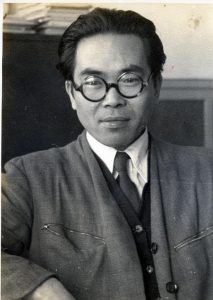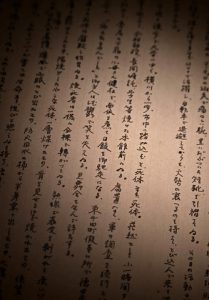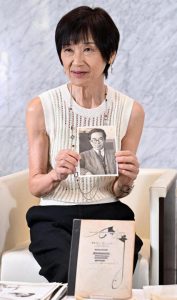Joji Kojima, assistant professor at Hiroshima University of Literature and Science, left behind journal describing scenes of scorched ruins near hypocenter right after A-bombing
Aug. 6, 2024
yle="font-size:106%;font-weight:bold;">Once they had lives, they had joys and sorrows, they spoke, they loved, and they were loved
by Minami Yamashita, Staff Writer
Joji Kojima, professor emeritus at Hiroshima University who died in 2006 at the age of 89, described in his journal shortly after the atomic bombing what he saw while walking near the A-bomb hypocenter two days after the atomic bomb was dropped on the city by the U.S. military. He was 28 years old at the time. He vividly described the tragedy from the eyes of a researcher, with consideration paid to the victims before their deaths.
Mr. Kojima, a specialist in petrology, was an assistant professor at Hiroshima University of Literature and Science, which was the predecessor to Hiroshima University. At the request of Japan’s Army, he had been conducting a geologic survey along the coast of the Seto Inland Sea near the area of Kaminoseki-cho, in Yamaguchi Prefecture, starting the beginning of August 1945. Accompanying him was a colleague, Shogo Nagaoka, who later became the first director of the Hiroshima Peace Memorial Museum and died in 1973 at the age of 71. Learning of Hiroshima’s destruction, they returned to the city on August 7.
The journal was written in a large-sized notebook, on whose cover were inscribed the words “From the day the four-nation Potsdam Declaration was accepted and the Imperial Rescript issued in 1945.” Mr. Kojima wrote, “Professor Imamura, Lecturer Nagaoka, students, and others are in front of the burned out main building.” At 9 a.m. on August 8, staff members and students had gathered in front of the main building of Hiroshima University of Literature and Science (present-day Hiroshima University, former Faculty of Science Building No. 1, located in the city’s Naka Ward). After checking on the status of the laboratories, they headed to the area near the hypocenter to search for missing exchange students from the former Manchuria (now northeastern China).
The notebook reads, “Stiffened corpses are beginning to decompose. Burned dead bodies are lying around naked.” In another excerpt he described how, “Some had both eyes popped out by the bomb’s blast, some were half-hanging out of a cistern used for fire prevention, and some had large intestines poking out of their bodies.” Mr. Kojima meticulously described the scorched ruins of Hiroshima. He mourned the dead, writing, “Once every one of them had life, they had joys and sorrows, they spoke, they loved, and they were loved.”
On August 11, he restarted his survey, and on August 15, he listened to the broadcast of the Emperor’s announcement of Japan’s surrender while standing in front of Moji Station (in present-day Kitakyushu City). After August 20, he spent time at a relative’s house in Ibaraki Prefecture. Since the journal entries in the notebook began on August 25, it is believed that the journal was written two weeks after the A-bombing.
Starting in October 1945, Mr. Kojima, along with Mr. Nagaoka and others, began collecting A-bombed rocks and roof titles as part of the earth science team of the Special Committee for the Investigation of Atomic Bomb Damages. They also worked hard to preserve the “Human Shadow Etched in Stone” at the former Hiroshima Branch of the Sumitomo Bank (in the city’s present-day Naka Ward), where the bombing’s thermal rays left a shadow-like imprint of a person who had been sitting there. Mr. Kojima’s second daughter, Akiko Kai, 68, a resident of Hiroshima’s Higashi Ward, found the journal in her father’s study 10 years after his death and has held on to it since.
Every year on August 6, when she was a child, Ms. Kai was told not to go out to play, and she with her family would visit the Atomic Bomb Memorial Mound in Peace Memorial Park, in Hiroshima’s Naka Ward, where they would put their hands together in prayer. She said she cannot forget her father gazing at the A-bomb Dome from the opposite river bank. Since retiring from her job as a teacher, Ms. Kai has been working as an A-bomb Legacy Successor of the Hiroshima City Government, using the notebook to pass on to others her father’s memories, saying, “They are objective memories. I want to communicate what a 28-year-old adult was thinking at the time of the A-bombing.”
(Originally published on August 6, 2024)










